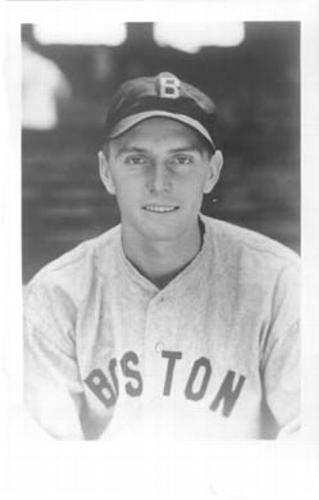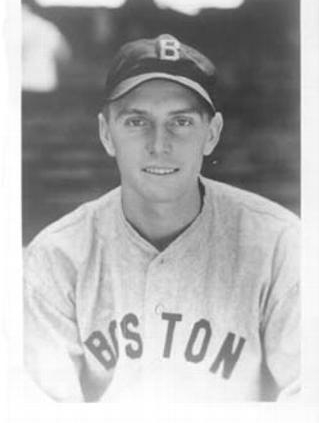September 22, 1935: Yankees sweep doubleheader in front of record crowd at Fenway Park
 When Fenway Park opened in 1912, its seating capacity was 24,000. In 1934, after a renovation under new owner Tom Yawkey, capacity increased to 33,200.1 (In 2024 the capacity was 37,535.2)
When Fenway Park opened in 1912, its seating capacity was 24,000. In 1934, after a renovation under new owner Tom Yawkey, capacity increased to 33,200.1 (In 2024 the capacity was 37,535.2)
With standing-room crowds, game attendance at Fenway topped 40,000 several times from 1934 through 1937. The peak announced attendance was 47,627 on Sunday, September 22, 1935, for a doubleheader against the New York Yankees. In other words, there were 14,427 more patrons than capacity – the park was sold out, packed to more than 40 percent above capacity. As the team’s 2022 Media Guide helpfully points out, “Crowds of this size will never be equaled under Fenway Park’s current dimensions. More stringent fire laws and league rules after World War II prohibited overcrowding that was permitted in the 1930s.”3
The actual crowd may have topped 49,000; the Boston Globe headline read: “Record Crowd of 49,000 Baseball Fans Jams Fenway Park.”4 The newspaper estimated that “10,000 more were turned away.”
The demand for standing room – or, as the Boston Herald called it, “squeezing room” – was so great that standing-room ticket sales were suspended well before game time. Portions of the overflow crowd were on the playing field itself in right field and right-center, held behind ropes.5
It wasn’t as though the American League pennant was on the line. The Globe noted that nothing hinged on the game more than the “practically settled fourth-place standing of the local club.”6 Indeed, after the previous day’s 5-2 loss to the Yankees, the Red Sox were 19 games behind the first-place Detroit Tigers. The Yankees were in second place, eight games behind Detroit. There were only seven games remaining to be played.
On the other hand, there were reasons for Boston fans to come to the ballpark. At 74-72, the Red Sox were aiming for their first winning record since the World Series championship season of 1918. This was the best Red Sox team in years, their best pitcher was going in the opening game, and they were playing the rival Yankees.
To say the Red Sox underperformed this day, dropping both games to fall to .500 for the season, would be an understatement. The Globe pulled no punches, declaring, “the Sox lapsed into some of their worst baseball of the year and lost both games.”7
Boston’s Wes Ferrell (24-13) was hoping to win number 25 in the first game. Starting for the Yankees was Red Ruffing (15-11).
The Yankees scored three runs in the top of the first. After two outs, Ferrell walked center fielder Ben Chapman. First baseman Lou Gehrig then hit a routine fly ball to right. Dusty Cooke started in but fell down, and the ball dropped in for a single as Chapman took third. The New York Times said Cooke “dropped his glove, stumbled and the fly went for a single.”8
Right fielder George Selkirk’s fly ball – lost in the glare of the sun – struck left fielder Roy Johnson flush, “hopping off his head”; Selkirk had an RBI double.9 After catcher Bill Dickey was walked intentionally, second baseman Don Heffner singled in two runs with a Texas Leaguer to center for a 3-0 Yankees’ lead.
New York added a fourth run in the top of the third when Heffner doubled in Selkirk, who had singled and then taken second on a subsequent error. The Yankees made it 5-0 in the fifth when the sun yet again blinded a Red Sox outfielder: Selkirk’s fly to Mel Almada in center field fell in for a leadoff triple. Two outs later, Selkirk scored on a single to left by Richardson.
Boston made it competitive by scoring three runs in the bottom of the fifth. First baseman Babe Dahlgren led off with an infield single to third base. Second baseman Ski Melillo walked. Ferrell – who entered the game batting .345 with 7 home runs in 1935 – singled to left field, loading the bases with nobody out.
Ruffing walked third baseman Dib Williams, forcing in Dahlgren. Cooke’s single to right field drove in two more. Yankees manager Joe McCarthy had local left-hander Vito Tamulis (he was born in Cambridge, Massachusetts, and grew up in Boston) relieve Ruffing. The 24-year-old Tamulis retired the next three batters in order.
The Red Sox closed to within a run in the sixth, when Dahlgren doubled with one out and Williams doubled with two outs. Dahlgren was 4-for-4 in the game.
The score stood 5-4 until the top of the ninth, when doubles by Gehrig and Dickey produced one more run. Tamulis retired the Red Sox in order in the bottom of the ninth; he had worked five innings of relief, allowing just four hits and two walks, and the one run. He was credited with his 10th win of the season, against five losses.
Ferrell’s record dropped to 24-14 with the loss. He finished 1935 as the AL’s leader in wins (25) and innings pitched (322⅓), and the majors’ leader in complete games with 31. He was second to Detroit’s Hank Greenberg in the Baseball Writers’ Association of America’s AL MVP voting.
The second game of the doubleheader proved to be a blowout as left-hander Jumbo Brown pitched for New York and held the Red Sox to four scattered base hits, all singles. Brown struck out eight Red Sox. Fritz Ostermueller started for Boston, giving up three runs in the third and three more in the fourth before being replaced by Jack Wilson (who faced two batters, both reaching) and then Rube Walberg. At that point, the “customers left by the hundreds.” After Wes Ferrell – who had a batting average of .258 or perhaps .267 in 30 or 31 at-bats as a pinch-hitter in 1935 – struck out batting for catcher Moe Berg for the second out in the fifth inning, “they left by the thousands.”10
In the seventh, Joe Glenn hit an RBI double off Walberg and in the top of the eighth, with Stew Bowers on the mound as Boston’s fourth pitcher of the game, Chapman doubled for two more RBIs. The game was halted after eight innings because of a Sunday curfew law. The Yankees collected 16 hits, including seven doubles, in the eight innings, winning 9-0.
The Red Sox rebounded with three home-field wins against the Philadelphia Athletics, all before much smaller crowds, to clinch their first winning record in 17 years. Their 78-75-1 record left them 16 games behind the Tigers.11
Author’s Note
Strictly speaking, the largest crowd before which the Red Sox – or any baseball team in the world – have ever played was the one totaling an official 115,300 sold tickets for an exhibition game on March 30, 2008, at the Los Angeles Coliseum. The Red Sox beat the Los Angeles Dodgers, 7-4.
Acknowledgments
This article was fact-checked by Mike Huber and copy-edited by Len Levin.
Sources
In addition to the sources cited in the Notes, the author consulted Baseball-Reference.com and Retrosheet.org.
https://www.baseball-reference.com/boxes/BOS/BOS193509221.shtml
https://www.baseball-reference.com/boxes/BOS/BOS193509222.shtml
Photo credit: Babe Dahlgren, Trading Card Database.
Notes
1 Philip J. Lowry, ed., Green Cathedrals (Phoenix: SABR, 2019), 47.
2 2022 Boston Red Sox Media Guide (Boston: Boston Red Sox, 2022), 292. The figure of 37,535 is for night games. The day-game capacity is 37,085. A section of bleacher seats in straightway center field (in the “batter’s eye”) is blocked off during day games.
3 2022 Boston Red Sox Media Guide, 299. As this author had previously written, “Newspaper reports indicate that 48,000 people crammed into Fenway Park – somehow – on August 12, 1934, of which 46,766 paid. Those who could see saw the Sox beat the Yankees 6-4 in the first game, but drop the second, 7-1.” In addition to those inside, the New York Times informs that “outside the portals of the park some 15,000 more stormed and fumed in the streets because they could get no nearer to the scene.” John Drebinger, “48,000 See Yanks and Red Sox Split,” New York Times, August 13, 1934: 17. See also Bill Nowlin, Red Sox Threads (Burlington, Massachusetts: Rounder Books), 532.
4 Gerry Moore, “Record Crowd of 49,000 Baseball Fans Jams Fenway Park,” Boston Globe, September 23, 1935: 1. Moore said that the crowd was also swollen by holders of complimentary tickets and also those who held rain checks from a truncated five-inning game on August 5, who had been offered free admission as guests of the Red Sox. Despite the large crowd, and only 14 policemen on hand, there were almost no injuries or problems, other than a man from Biddeford, Maine, struck above the right eye by a broken bottle “thrown during one of the barrages which some of the inhabitants of the bleachers unleashed on the overflow patrons, standing on the field, in a protest to the latter’s obstructing the bleacherites’ view.” Moore, 9. Moore said the large crowd was “a tribute to the hustling and fighting qualities” of manager Joe Cronin’s team.
5 Burt Whitman, “Record Red Sox Crowd, 47,627 Fans, See Yankees Win Twin Bill, 6-4, 9-0,” Boston Herald, September 23, 1935: 1. Photographs show the crowd standing maybe eight deep.
6 Moore.
7 Moore.
8 Roscoe McGowen, “47,627 See Yankees Halt Red Sox by 6-4 and 9-0,” New York Times, September 23, 1935: 22.
9 Whitman.
10 Whitman. While Baseball-Reference.com shows .267 with 30 AB in 34 games, Retrosheet shows a .258 batting average with 31 AB in 35 games.
11 The Yankees, who won eight of their final nine games in 1935, wound up just three games out of first place.
Additional Stats
New York Yankees 6
Boston Red Sox 4
New York Yankees 9
Boston Red Sox 0
Fenway Park
Boston, MA
Box Score + PBP:
Game 1:
Game 2:
Corrections? Additions?
If you can help us improve this game story, contact us.


